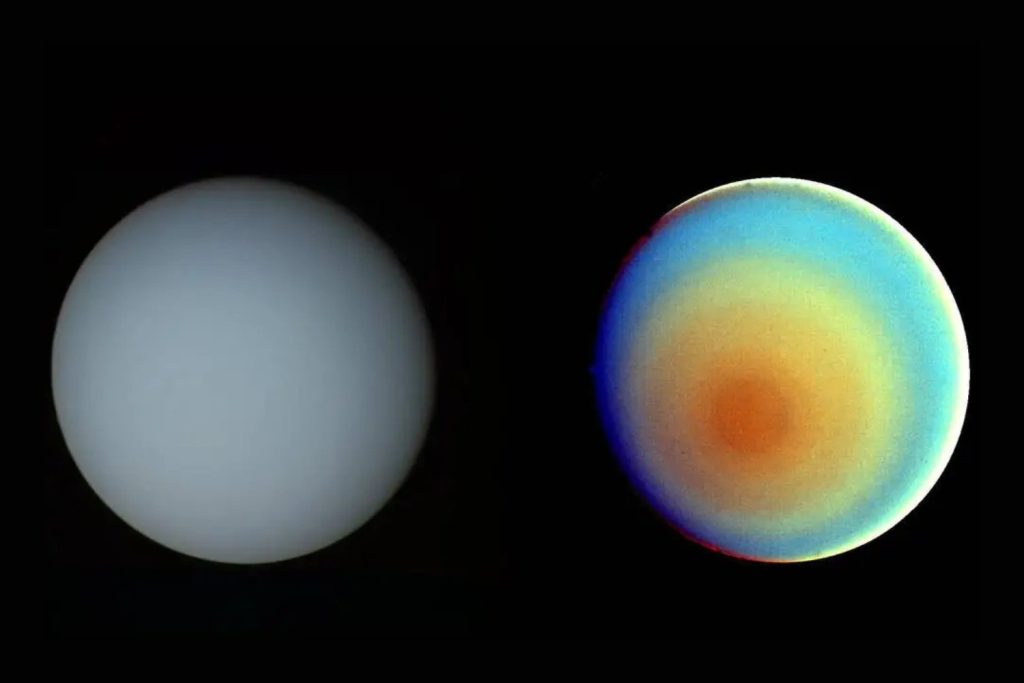A recent analysis of 38-year-old Voyager 2 data indicates that the intrepid spacecraft flew past Uranus at an unusual moment when the planet’s magnetosphere was warped by particles from the Sun.
The research—published today in Nature Astronomy—suggests that the magnetic structure of the Uranian system is different than initially thought. Initial analysis of the Voyager 2 data suggested that the planet’s magnetosphere—the area around Uranus dominated by its magnetic field—was devoid of plasma, which is present in other planetary magnetospheres.
The data also indicated that the Uranian magnetosphere had intense belts of energetic electrons, unlike that of other planets. Besides being the butt of so many jokes, Uranus’ environs appeared to be bizarre compared to the rest of our solar system.
The scientists behind the updated research posit that these unusual circumstances were actually the result of an intense blast of solar wind—charged particles from the Sun’s atmosphere—which warped the magnetosphere just as Voyager 2 flew past in 1986.
“These were two major mysteries leftover from the Voyager 2 flyby, both of which can be reasonably explained by the arrival of an intense solar wind event that compressed the magnetosphere dramatically just before the flyby started,” said Jamie Jasinski, a planetary scientist at NASA’s Jet Propulsion Laboratory and Caltech, and the study’s lead author, in an email to Gizmodo.
“If we had arrived a week earlier with Voyager 2 then the spacecraft would have made completely different measurements, and our discoveries would have been very different,” Jasinski said. “Voyager 2 arrived at just the wrong time!”
The rare compression of the magnetosphere only occurs 4% of the time around Uranus, according to the team’s estimates. The other 96% of the time, the planet’s magnetosphere isn’t so extreme. The findings also suggest that during the solar minimum—the low point of the Sun’s 11-year cycle—Uranus experiences alternating periods of disturbed solar wind that affect its magnetosphere. The cycles during which the magnetosphere is “open” or “closed” to the solar wind may be due to Uranus’ tilt, which is extreme relative to the solar system’s orbital plane.
Based on the Voyager 2 data, the team concluded that “the Uranian magnetosphere may well have had two cycles at the time of the Voyager 2 flyby: the first varying on a diurnal timescale due to the ‘switch-like’ or ‘open-closed’ processes mentioned above, and the second due to the varying solar wind conditions.”
Voyager 2 is the only spacecraft to visit Uranus and Neptune; it also discovered 16 moons and six planetary rings as it made its way out of our solar system. Voyager 2 is now 47 years and two months into its mission, traveling through interstellar space at 34,391 miles per hour (55,347 kilometers per hour). The mission is nearly 13 billion miles (20.9 billion kilometers) from Earth—over 138 times the distance between Earth and the Sun. Voyager 2 is so distant that it takes light over 19 hours to travel from the spacecraft to Earth.
Over the last 35 years, NASA enacted power-saving measures that have turned off all but four of the Voyager spacecraft instruments: the two missions’ cosmic ray subsystems, magnetometers, and instruments for measuring charged particles and electrical fields remain operational.
“It’s an exciting work,” said Carol Paty, a planetologist at the University of Oregon who is not affiliated with the recent paper, in a phone call to Gizmodo. “It’s always wonderful when you can go back to data that’s decades old with fresh eyes and fresh perspective.”
As the new study suggests, Voyager 2 observed a particularly extreme event involving Uranus’ magnetosphere, but Paty noted that it would be a step too far to assume the gas giant’s typical state is similar to that of other planets in our solar system. Uranus’ magnetosphere is still very asymmetric, and the angle of the planet’s rotation still means that it has some of the most extreme seasons of any world in the solar system.
“What we know from looking at this paper, just from the upstream solar wind data analysis alone, the solar wind is quite variable even out at the orbital distance of Uranus,” Paty said. “And that variability means that this system is going to be incredibly dynamic and responsive to the solar wind.”
Uranus is an exciting venue for astrobiology—that’s life off Earth, not biology in your…never mind. In 2022, a 780-page report by the National Academies of Sciences, Engineering, and Medicine called for a Uranus orbiter capable of mapping the planet’s gravitational and magnetic fields and even launch an atmospheric probe into its skies.
Separate from the report, planetary scientists have made similar arguments; Uranus has many mysteries, and no spacecraft has visited it since Voyager 2. The mission’s images of the planet and its moons continue to be the main data on which planetary scientists rely when producing new research about Uranus, as indicated by a paper last week on the possibility of a subsurface ocean on Miranda, one of the planet’s moons.
In the new findings, the team also concluded that Uranus’ outermost moons, Titania and Oberon, orbit inside the planet’s magnetosphere instead of outside it. That would make it much easier for a spacecraft to determine the presence of a subsurface ocean, which it does by inducing a magnetic field response from the liquid water below the moon’s surface.
“Titania and Oberon are the most likely candidates for harboring oceans because they are slightly larger than the other moons, meaning they can retain heat better, and therefore be warmer,” Jasinski said. “This means they are less likely to be completely frozen.” And based on the team’s review of the Voyager data, those plausibly liquid contents of the moons would be easier to detect than previously thought.
It’s high time we got our asses to Uranus. But until then, scientists will extract every last bit of insight from the data collect by Voyager nearly 40 years ago.

